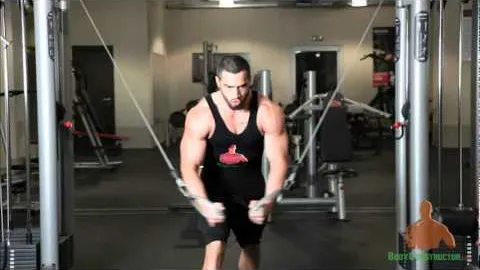

If you are looking to strengthen your chest and shoulders, the cable crossover fly exercise is an excellent choice. This compound exercise targets multiple muscle groups simultaneously, providing a highly efficient workout. In this article, we will dive into the details of the cable crossover fly exercise, its benefits, and how to incorporate it into your fitness routine.
The cable crossover fly exercise offers a wide range of benefits, making it a popular choice among fitness enthusiasts. Here are some key advantages:
Muscle Activation: The cable crossover fly primarily targets the pectoralis major, the largest muscle in the chest. It also engages the anterior deltoids (shoulders) and the triceps, providing an effective upper body workout.
Balanced Muscle Development: This exercise helps maintain balanced muscle development by targeting both the inner and outer chest muscles. It helps sculpt and define the chest, creating a more aesthetic appearance.
Increased Range of Motion: Unlike other chest exercises, the cable crossover fly allows for a greater range of motion. This increased range targets the chest muscles from various angles, stimulating growth and strength.
Functional Movement: The cable crossover fly mimics functional movements, such as pushing and grabbing objects. By incorporating this exercise into your routine, you can improve your overall upper body strength and stability.
Versatility: This exercise can be adjusted to suit your fitness level. By modifying the weight, angle, and grip, you can easily tailor the cable crossover fly to your specific needs and goals.
To perform the cable crossover fly exercise, follow these step-by-step instructions:
Setup: Stand in the center of a cable machine, ensuring both cables are at shoulder height. Attach a D-handle to each cable and step forward with one foot, creating a stable stance.
Grip: Grasp each D-handle with a neutral grip (thumbs up). Keep your elbows slightly bent and your palms facing forward.
Stance: Position your feet shoulder-width apart, maintaining a slight bend in your knees. Engage your core muscles to stabilize your body throughout the exercise.
Movement: Start by bringing your hands in front of your chest, keeping your elbows slightly bent and maintaining a slight squeeze in your chest muscles. This is your starting position.
Execution: Simultaneously extend your arms out to the sides, maintaining a slight bend in your elbows. Focus on squeezing your chest muscles together as you reach the end of the movement.
Controlled Return: Slowly reverse the movement to bring your hands back to the starting position, maintaining tension in your chest muscles throughout the exercise.
Repetitions: Perform 8-12 repetitions for optimal muscle stimulation. As you progress, you can increase the weight and repetitions to continue challenging your muscles.
To ensure a safe and effective cable crossover fly workout, keep the following tips in mind:
Warm up: Before starting this exercise, it is essential to warm up your muscles. Engage in a light cardio activity, such as jogging or cycling, for 5-10 minutes to prepare your body for the workout.
Proper Form: Maintain proper form throughout the exercise to maximize its benefits and prevent injuries. Focus on keeping your back straight, shoulders down, and core engaged at all times.
Breathing Technique: Inhale during the outward movement (arms extending), and exhale during the inward movement (arms returning to the starting position). This breathing pattern provides stability and promotes efficient muscle engagement.
Controlled Movements: Emphasize controlled movements rather than speed. Avoid using momentum to prevent strain or injury. Slow and controlled movements ensure optimal muscle activation and growth.
Gradual Progression: Start with lighter weights and gradually increase the resistance as you gain strength and confidence in the exercise. Avoid excessive weight that compromises your form or causes discomfort.
To incorporate the cable crossover fly exercise into your fitness routine, consider the following guidelines:
Frequency: Aim to perform the cable crossover fly exercise 1-2 times per week, allowing ample rest and recovery between sessions.
Supplemental Exercises: Combine the cable crossover fly with other chest and shoulder exercises for a well-rounded workout. Bench press, push-ups, shoulder press, and lateral raises are some excellent choices.
Sets and Repetitions: Start with 2-3 sets of 8-12 repetitions, gradually increasing the intensity as your strength improves.
Progressive Overload: To continue challenging your muscles and promote growth, gradually increase the weight or resistance over time.
Listen to Your Body: Pay attention to any discomfort or pain during the exercise. If you experience any issues, consult with a fitness professional or healthcare provider.
The cable crossover fly exercise is a powerful compound movement that targets the chest and shoulders. By incorporating this exercise into your fitness routine, you can strengthen these muscle groups, improve range of motion, and achieve balanced muscle development. Remember to prioritize safety and proper form during your workouts and gradually increase the intensity as your strength grows. Enjoy the benefits of the cable crossover fly as you work towards your fitness goals!
If you're looking for a gym, fitness club or yoga studio, you've come to the right place.
You can find information about gyms in your area. Browse catalog of gyms and find gyms with classes which are you looking for.
On gym page you can find simple information like address, phone or website. You can find list of available classes. You can check availability of personal training or small group classes. On place page you can also see information about open hours.
You can find gyms near you with amenities, courts, studios and equipments.
Use our map to find gym at your city or district.
In Gym Navigator you can find list of exercises with movies for many body parts.
You can browse exercises catalog and find exercises the best of you.
You can also find exercises grouped into workout plans, which you can use to improve you body. Each routine show you exercises one by one and give you possibility to count you progress and count down rest time.